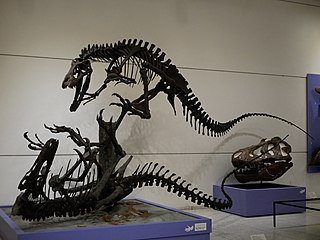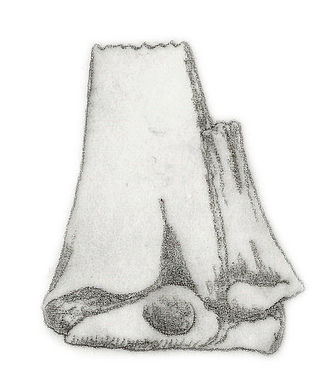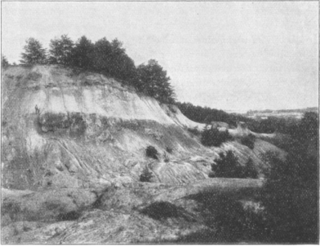
Claosaurus is a genus of hadrosauroid dinosaur that lived during the Late Cretaceous Period (Santonian-Campanian).

Appalachiosaurus is a genus of basal eutyrannosaurian theropod dinosaur from the middle Campanian age of the Late Cretaceous period of what is now eastern North America. Like most theropods, it was a bipedal predator. Only a juvenile skeleton has been found, representing an animal approximately 6.5 metres (21 ft) long and weighing 623 kilograms (1,373 lb), which indicates an adult would have been significantly larger. It is the most completely known theropod from eastern North America.

Tyrannosauroidea is a superfamily of coelurosaurian theropod dinosaurs that includes the family Tyrannosauridae as well as more basal relatives. Tyrannosauroids lived on the Laurasian supercontinent beginning in the Jurassic Period. By the end of the Cretaceous Period, tyrannosauroids were the dominant large predators in the Northern Hemisphere, culminating in the gigantic Tyrannosaurus. Fossils of tyrannosauroids have been recovered on what are now the continents of North America, Europe and Asia, with fragmentary remains possibly attributable to tyrannosaurs also known from South America and Australia.

Dryptosaurus is a genus of basal eotyrannosaurian theropod dinosaur that lived on the island continent of Appalachia approximately 67 million years ago during the end of the Maastrichtian age of the Late Cretaceous period. Dryptosaurus was a large, bipedal, ground-dwelling carnivore that could grow up to 7.5 metres (25 ft) long and weigh up to 756–1,500 kilograms (1,667–3,307 lb). Although it is now largely unknown outside of academic circles, the famous 1897 painting of the genus by Charles R. Knight made Dryptosaurus one of the more widely known dinosaurs of its time, in spite of its poor fossil record. First described by Edward Drinker Cope in 1866 and later renamed by Othniel Charles Marsh in 1877, Dryptosaurus is among the first theropod dinosaurs ever known to science.
"Coelosaurus" antiquus is a dubious species of theropod dinosaurs. It was named by Joseph Leidy in 1865 for two tibiae found in the Navesink Formation of New Jersey.

Ornithotarsus is a genus of hadrosaurid ornithopod dinosaurs that lived in North America during the Late Cretaceous Period in what is now the Merchantville Formation about 84 million to 78 million years ago.

Santanaraptor is a genus of tyrannosauroid theropod dinosaur that lived in South America during the Early Cretaceous, about 112 million years ago.

The Judith River Formation is a fossil-bearing geologic formation in Montana, and is part of the Judith River Group. It dates to the Late Cretaceous, between 79 and 75.3 million years ago, corresponding to the "Judithian" land vertebrate age. It was laid down during the same time period as portions of the Two Medicine Formation of Montana and the Oldman Formation of Alberta. It is an historically important formation, explored by early American paleontologists such as Edward Drinker Cope, who named several dinosaurs from scrappy remains found here on his 1876 expedition. Modern work has found nearly complete skeletons of the hadrosaurid Brachylophosaurus.
The Milk River Formation is a sandstone-dominated stratigraphic unit of the Western Canada Sedimentary Basin in southern Alberta, Canada. It was deposited in near-shore to coastal environments during Late Cretaceous time. Based on uranium-lead dating, palynology and stratigraphic relationships, deposition occurred between ~84.1 and 83.6 Ma.
The Mooreville Chalk is a geological formation in North America, within the U.S. states of Alabama and Mississippi, which were part of the subcontinent of Appalachia. The strata date back to the early Santonian to the early Campanian stage of the Late Cretaceous. The chalk was formed by pelagic sediments deposited along the eastern edge of the Mississippi embayment. It is a unit of the Selma Group and consists of the upper Arcola Limestone Member and an unnamed lower member. Dinosaur, mosasaur, and primitive bird remains are among the fossils that have been recovered from the Mooreville Chalk Formation.
The Bostobe Formation is a geological formation in Qaraghandy & Qyzylorda, Kazakhastan whose strata date back to the Late Cretaceous.
The Navesink Formation is a 66 to 70 mya greensand glauconitic marl and sand geological formation in New Jersey. It is known for its Cretaceous period fossil shell beds and dinosaur bones.
The Harebell Formation is a Late Cretaceous (Maastrichtian) geologic formation in Wyoming which outcrops in parts of the Yellowstone National Park. Dinosaur remains diagnostic to the genus level are among the fossils that have been recovered from the formation.
The Marshalltown Formation is a Mesozoic geologic formation. Dinosaur remains diagnostic to the genus level are among the fossils that have been recovered from the formation.
The Tamayama Formation is a Santonian geologic formation in Japan. Dinosaur remains not referrable to the genus level are among the fossils that have been recovered from the formation. The lower and middle part of the formation consists of braided river sandstone, while the upper portion consists of upper shoreface to inner shelf sandstone. Fossil plants are known from the formation, along with a species of Inoceramus and a sauropod dinosaur.
The Ialovachsk or Yalovach Formation is a geologic formation in Kyrgyzstan, Tajikistan and Uzbekistan dating to the Santonian age of the Cretaceous period.

During most of the Late Cretaceous the eastern half of North America formed Appalachia, an island land mass separated from Laramidia to the west by the Western Interior Seaway. This seaway had split North America into two massive landmasses due to a multitude of factors such as tectonism and sea-level fluctuations for nearly 40 million years. The seaway eventually expanded, divided across the Dakotas, and by the end of the Cretaceous, it retreated towards the Gulf of Mexico and the Hudson Bay. This left the island masses joined in the continent of North America as the Rocky Mountains rose. From the Cenomanian to the end of the Campanian ages of the Late Cretaceous, Appalachia was separated from the rest of North America. As the Western Interior Seaway retreated in the Maastrichtian, Laramidia and Appalachia eventually connected. Because of this, its fauna was isolated, and developed very differently from the tyrannosaur, ceratopsian, hadrosaurid, pachycephalosaur and ankylosaurid dominated fauna of the western part of North America, known as "Laramidia".
The Black Creek Group is a geologic group in North Carolina. It preserves fossils dating back to the Late Cretaceous period.

The Potomac Group is a geologic group in Delaware, Maryland, New Jersey, and Virginia. It preserves fossils dating back to the Cretaceous period. An indeterminate tyrannosauroid and Priconodon crassus, a nodosaurid, are known from indeterminate sediments belonging to the Potomac Group. The Potomac Group was initially believed to have been Late Jurassic in age by Othniel Charles Marsh but later studies, such as Clark (1897), have found that the Potomac Group is in fact Early-Late Cretaceous (Aptian-Turonian) in age.
The Cedar District Formation is a geologic formation exposed on Vancouver Island, the Gulf Islands of British Columbia and San Juan Islands of Washington (state). It preserves fossils dating back to the Campanian Epoch of the Cretaceous period. It dates to the lower mid-Campanian.








